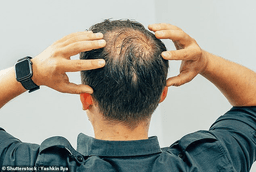If you’re worried about your hairline, you’re not alone. Most men will experience hair loss at some point in their lives.
Minoxidil is one of the main treatments for it. But does it really work? Read on to find out.
Key Takeaways
- Minoxidil promotes hair growth by increasing blood flow to your hair roots
- It works for most people: in studies, 59-82% of people saw an improvement
- Usually, it takes around a year to see maximum results

How does minoxidil work?
Your hair follows a natural cycle of growth and shedding. When you start to lose your hair, the growth phase gets shorter and your follicles start to shrink. Your hairs grow shorter and finer until the follicles close up altogether and hairs stop coming out.
Minoxidil encourages hair growth by increasing blood flow to your hair roots. This is thought to prolong the growth phase.
Heads up: Minoxidil is available as tablets or as a topical treatment (a spray or foam) you apply to your scalp. The topical version is licensed for male hair loss and is sold under the brand name Regaine. And it’s available at MANUAL.
The tablets are licensed for high blood pressure but are sometimes used off-label for hair growth. See our guide on oral vs topical minoxidil to compare both options.
How long does minoxidil take to work?
It usually takes around six months for topical minoxidil to have an effect. Though it can take a year to see maximum results.
Good to know: Some people notice an increase in hair shedding when they first start minoxidil. This usually resolves within six weeks.
Minoxidil results: What to expect
So, does minoxidil work? Yes, it does. Here’s what the research says:
- Topical minoxidil causes hair regrowth on both the front and crown of the head, with results peaking after a year
- Higher-strength topical minoxidil (5%) led to 45% more hair regrowth than a 2% dose. Men using the 5% dose also saw results sooner.
- In a review of 27 studies (including a total of 2,933 people), oral minoxidil improved hair loss symptoms in 82% of people. Thirty-five percent saw a significant improvement.
- Even at low doses, oral minoxidil can drive improvements in hair diameter and density.
- Minoxidil foam can increase hair density, width, and scalp coverage on both the front and crown of the head.
Does minoxidil work forever?
There will come a time when your results will plateau. Usually, this is around the 12-month mark of using minoxidil. But staying on the medicine will help maintain your results.
Minoxidil isn’t a “cure” for male pattern baldness—it doesn’t treat the root cause (your genes). Rather, it prevents hair loss while you’re taking it. So, if you come off minoxidil, your hair loss will progress as it would naturally.
Not sure what’s best for you? Our team of clinicians and hair experts can advise on long-term hair loss treatments. Take our quiz to get started.
Does minoxidil work for everyone?
It works for most people. Studies estimate that it’s effective in 59-82% of men dealing with hair loss.
Minoxidil is meant for men aged 18-65 who are experiencing male-pattern hair loss, aka hereditary hair loss. It can be prescribed for men over the age of 65, if the benefits outweigh the risks or side effects, after a clinical review (this is called off-label prescribing)
You shouldn’t take it if you have:
- Sudden or patchy hair loss. Hereditary loss usually recedes at the temples, then the crown. Sudden or uneven loss needs medical assessment first.
- Scalp disease or broken skin if using topical minoxidil. Conditions like psoriasis, severe dermatitis or infection can worsen.
- Long-standing complete baldness. Minoxidil needs active follicles to work.
- Uncontrolled blood pressure, whether it’s too high or too low.
- Recent cardiovascular events: Heart attack, stroke or mini-stroke within the last 6 months.
If you’re keen to give minoxidil a try, we’ve got you. Take our quiz to find out which scientifically-proven treatment is best. Then, our team of experts will put together a personalised plan to get your hair back.





